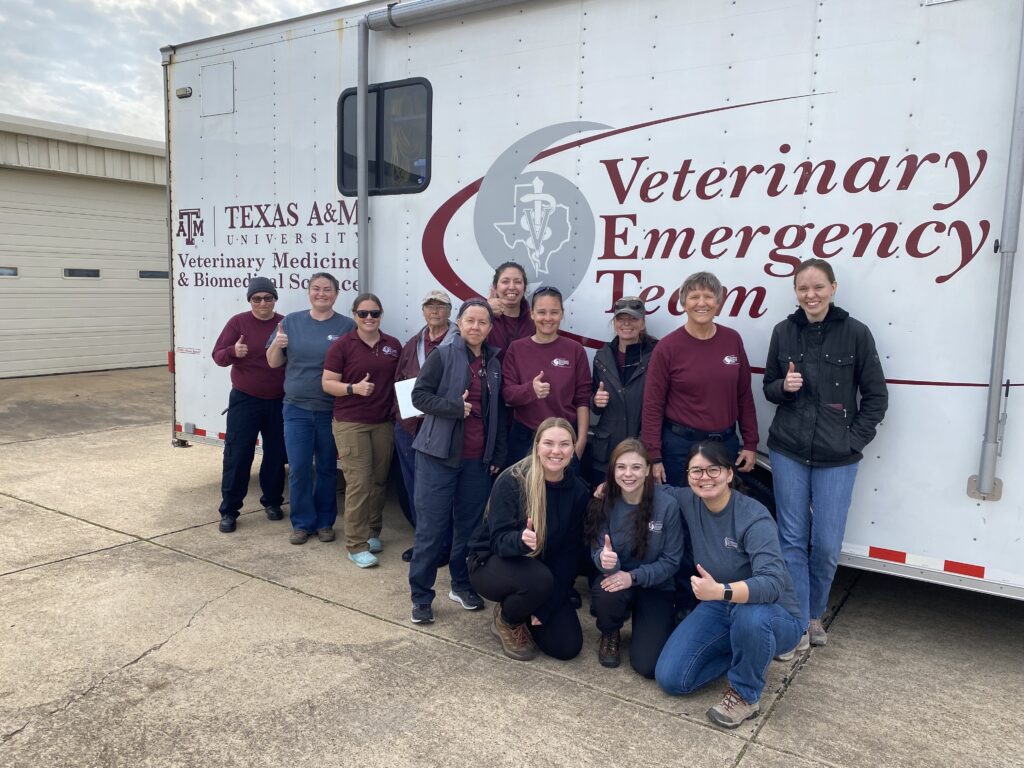Texas A&M Veterinary Emergency Team Deploys To Texas Panhandle In Response To Wildfire
Story by Rachel Knight, VMBS Communications

The Texas A&M Veterinary Emergency Team (VET) deployed Wednesday to the Texas Panhandle in response to a fast-moving wildfire that quickly became the second-largest in Texas history.
The team’s mission includes providing veterinary care in support of 12 search and rescue dogs deployed with Texas A&M Texas Task Force 1 and to resident animals while also supporting local shelters.
“Working dogs are critical to the success of search and rescue efforts, and our role is to make sure they have the nutrition, post-work rehabilitation, and veterinary care they need to continue providing hope and answers to loved ones of those in the affected area,” said Dr. Deb Zoran, VET director.
Nine members of the team and five Doctor of Veterinary Medicine students left Bryan-College Station for the Texas Panhandle Wednesday morning, with additional members of the team joining the group Thursday to better support the growing number of animals impacted by the fire.
“Fires are unpredictable and often enter a community without warning; when this happens, more people and animals are likely to be affected,” Zoran said. “In these situations, it’s critical that we begin helping to take care of affected animals and support the local veterinary community as quickly as possible.”
The largest in a cluster of five fires burning across the region, the Smokehouse Creek Fire was estimated at 850,000 acres, with 3% containment on Wednesday. The fire began on Monday in Hutchinson County in warm, dry, and windy conditions. Evacuations and road closures for the town of Candadian had been lifted Wednesday afternoon.
Texas Gov. Greg Abbott issued a disaster declaration for 60 Texas counties on Tuesday and activated a number of state agencies to provide resources for wildfire response operations. The Texas A&M Forest Service said 25 bulldozers and nearly 300 firefighters from across the state had been dispatched to the region.
As the largest and most sophisticated team of its kind in the country, the VET comprises faculty, staff and students from the Texas A&M College of Veterinary Medicine & Biomedical Sciences (VMBS) as well as volunteers from the veterinary profession and beyond.
The team has previously assisted in wildfire responses in Bastrop, Texas, in 2011 and in Eastland County, Texas, in 2022, as well as in Paradise, California, in 2018-2019 and near Oroville, California, in 2020.
“No two deployments are the same, but deployments in response to the same type of disaster often share some aspects,” Zoran said. “When we deploy in response to wildfires, we know we’re going to see burn victims, we know we’re going to have to work hard to keep the search and rescue dogs safe, and we know that the hope we provide by supporting the search teams and by helping reunite a family with a beloved pet is invaluable and more than worth the hard work that goes into disaster response efforts.”
Thanks to the generosity of donors who provide a majority of the VET’s funding, the team is eager to help their fellow Texans as the blaze continues to burn through the Panhandle community.
“We rely heavily on our donors who see the value in what we do and who love our mission of supporting every Texan every day,” Zoran said. “Thanks to donations made to the team, we stand ready to serve when the unthinkable happens.”
To learn more about the VET, visit vetmed.tamu.edu, and to support the VET on this mission, visit tx.ag/SupportTheVET.
###
For more information about the Texas A&M College of Veterinary Medicine & Biomedical Sciences, please visit our website at vetmed.tamu.edu or join us on Facebook, Instagram, and Twitter.
Contact Information: Jennifer Gauntt, Director of VMBS Communications, Texas A&M College of Veterinary Medicine & Biomedical Sciences, jgauntt@cvm.tamu.edu, 979-862-4216


